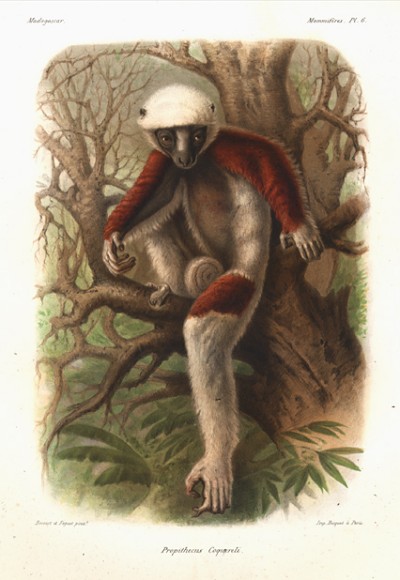Coquerel's Sifaka (Propithecus coquereli) [Photo] An illustration of Propithecus coquereli by Alfred Grandidier from: http://www.tsidy.com/lemurs/grandidier/grandoverview.asp
Coquerel's Sifaka
Coquerel's sifaka (Propithecus verreauxi coquereli) are delicate leaf-eaters from the dry northwestern forests of Madagascar. In addition to P.verreauxi, there are three species of sifaka. These include the golden-crowned sifaka (Propithecus tattersalli) and the diademed sifaka (Propithecus diadema diadema). Both Propithecus verreauxi and Propithecus diadema each have four different subspecies.
The Sifaka of Madagascar are distinguished from other lemurs by their mode of locomotion: these animals maintain a distinctly vertical posture and leap through the trees using just the strength of their back legs. Their spectacular method of locomotion is known as vertical clinging and leaping and their long, powerful legs can easily propel them distances of over 20 feet from tree to tree. On the ground, the animals cross treeless areas just as gracefully, by an elegant bipedal sideways hopping.
The Malagasy name 'sifaka' comes from the distinct call this animal makes as it travels through the trees: "shif - auk".
Feeding
Coquerel's Sifaka feed on young leaves, flowers, fruit, bark and dead wood in the wet season, and mature leaves and buds in the dry season. Leaves make up a significant portion of the sifaka diet both in the wild as well as in captivity. In fact, the digestive system of these folivorous primates requires that a certain percentage of the diet be in the form of browse. As many as 98 different plant species have been recorded in their diet. However, only 12 of these plants make up two thirds of the diet. Foraging activities occupy between 30 and 40% of the day.
During the warmer months, sifakas at the Lemur Center receive a daily selection of fresh browse harvested from nearby fields and forests. This browse consists of a variety of some of the ten different species of North Carolina leaves the sifakas enjoy. In the fall, four chest freezers are each filled with packages of sumac leaves, so that each of our sifakas will also receive leaves during the winter months.
Fact Sheet
Order: Primates; Suborder: Prosimii
Family: Indriidae; Genus: Propithecus
Species: verrauxi; Subspecies : coquereli
Related Species
See Diademed Sifaka.
Key Facts
Adult Size : 7.3 - 9.9 pounds
Social life : Sociable, small family groups of 3 - 10 animals of varying ages
Habitat : northwestern dry deciduous forest
Diet : young leaves, flowers, fruit, bark and dead wood in the wet season, mature leaves and buds in the dry season
Lifespan : 25 - 30 years
Sexual maturity : 2 - 3 years
Mating : very seasonal, January - February in the wild
Gestation : approximately 162 days, infants are born between June and July in the wild
Number of young : one per year
DLC Naming theme : Roman Emperors (Julian, Marcella, Nigel, etc.)
Malagasy names : Tsibahaka, Sifaka, Ankomba Malandy
Interesting Facts
The Malagasy name 'sifaka' comes from the distinct call this animal makes: "shif - auk".
The DLC houses the only breeding colony of Coquerel's sifaka.
Our very own Jovian, a young male Coquerel's sifaka, is the star of the children's television show, Zoboomafoo.
Reproduction
In the wild, female Coquerel's sifaka give birth to one offspring in mid-summer, after a gestation period of approximately 162 days. Infants cling to their mothers' bellies for the first three to four weeks of life. Then, the young sifaka will begin spending a gradually increasing amount of time riding, jockey style, on mom's back. Infants continue to ride their mother's back, if allowed, during times when they feel threatened until they are five months old. However, by the time the infants are three or four months old, mothers will begin to nip at them to encourage the infants to find an alternate method of transportation! Infants begin to sample solid foods and leaves at three or four weeks, and might begin to take a few tentative steps away from their mothers at this time. Nursing continues, in a steady decline in importance in the infant's diet, until it is weaned at approximately 5 - 6 months of age.
Young become sexually mature at around the age of 3.5 years. At this point at the DLC, they might be removed from their family groups for formation of a new breeding pair.
Social Behavior
Coquerel's sifaka live in social groups of between 3 and 10 individuals, and age and sex composition of the groups vary widely. Females are dominant to males, which gives them preferential access to food and the choice of with whom to mate. A home range of between 10 and 22 acres (4 - 9 ha) is maintained by the wild groups. However, within this area, a core territory of two to three hectares is utilized over 60% of the time.
At the Lemur Center sifakas are maintained in family groups of up to six members. Breeding occurs in late summer to early fall and single infants are born in late winter to early spring
Habitat/Conservation
The Lemur Center's colony of Coquerel's sifaka is the most successful breeding colony in the world of this species or any species of sifaka. The Center maintains 21 animals (12 males, 9 females). The Lemur Center has been successful enough with our breeding program to send animals to other zoological institutions. The Los Angeles Zoo has a breeding group of four animals (an adult pair and their offspring), the Philadelphia Zoo has a sibling pair, and the St. Louis Zoo has a breeding group. The Paris Zoo has the only other established breeding group of sifakas in the world.
Coqerel's sifaka might be the most threatened of the verreauxi subspecies because of habitat destruction. It is found only in the Ankarafantsika Nature Reserve and the Bora Special Reserve, and these have both been damaged by yearly fires set by nearby farmers. Hunting of these animals by locals might occur in some areas, although in many parts of its range it is protected by taboo or fady.
